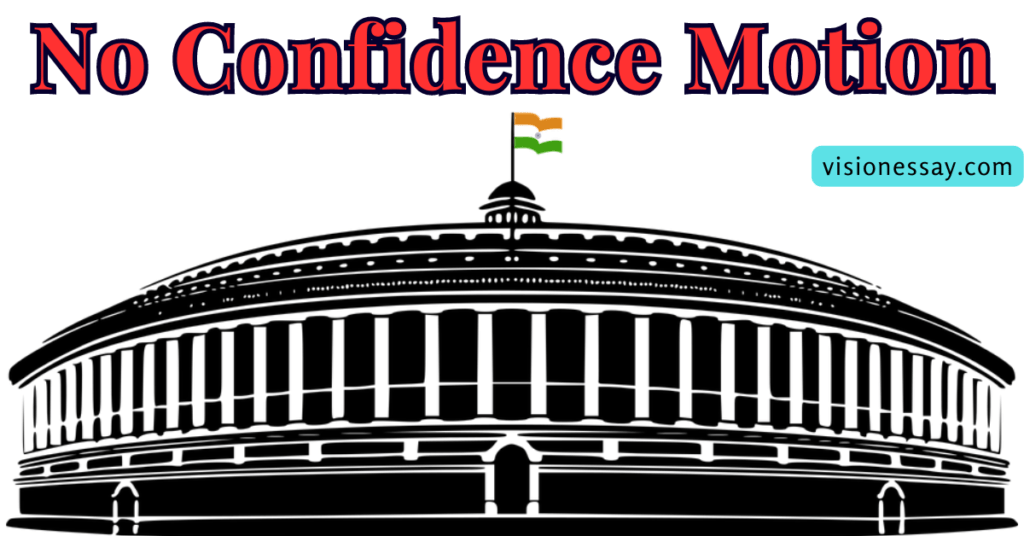
Introduction
Due to the deadlock with the opposition over the violence in the state of Manipur, a no confidence motion in the government of Indian Prime Minister Narendra Modi will be presented in parliament. A recent proposal for an adjournment of the Lok Sabha was made by a member of parliament who cited the urgent necessity for discussions about ethnic violence in Manipur. A motion is a formal request for a debate or vote on a subject made by a member of a House of Parliament.
What Kinds of Motions Are Used in Parliament?
- No Confidence Motion
- This resolution was introduced in the Lok Sabha (rather than the Rajya Sabha) to assess public trust in the government.
- Fifty members must vote in favor of the motion in order for it to pass.
- Closure Motion
- A member made the motion to adjourn the discussion of an issue before the House. If the motion is adopted by the House, the discussion is immediately over and a vote is taken.
- Motion with a Vote
- This kind of motion is submitted to the Lok Sabha in accordance with Rule 184. It enables a discussion with a vote on a particular subject, and the result of the vote establishes the stance of Parliament.
- If such a motion is approved, the government is required to abide by the outcome of the vote in Parliament.
- Short Duration Discussion
- Short-term talks may be held in accordance with Rules 176 and 193 of the Rajya Sabha and the Lok Sabha, respectively.
- MPs can consider a particular matter of public concern for a brief period of time without voting on it. The discussion often lasts for a certain amount of time, not longer than two hours.
- Adjournment Motion
- A motion for adjournment is made with the Speaker’s approval to consider a specific issue of urgent public interest that must be of the utmost concern.
- To be accepted, it requires the approval of 50 members. It is considered an exceptional device since it interferes with the House’s regular business.
- The Lok Sabha has this motion, however, the Rajya Sabha does not.
- Confidence Motion
- When the President asks administrations with slender majorities to demonstrate their majorities on the House floor, it is passed.
- The vote confirms the government’s continuing authority to rule.
- Privilege Motion
- When a member thinks a minister has mistreated the House’s or its members’ privileges by concealing crucial details of a case or offering falsified and distorted information, they may bring this motion.
- This motion’s main goal is to express dissatisfaction and condemnation of the relevant minister’s deeds.
- Motion of Thanks
- Thanking the President for his address at the start of the Lok Sabha is a custom in parliament.
- The motion is put to a vote at the conclusion of the discussion. The House must approve this measure. Otherwise, the government will be overthrown.
- Cut Motion
- Proposed to lower the budget’s demand size.
- Their adoption by the Lok Sabha equates to a lack of parliamentary support for the administration and might result in its resignation.
Also Read: Manipur Violence 2023
Who can Move No Confidence Motion?
Only in the Lok Sabha may a no confidence motion be lodged. In Rajya Sabha, it is immovable. A motion of no confidence may be proposed by any Lok Sabha member. However, the proposal must have the backing of at least 50 House members.
What happens If the Government Prevails in the No Confidence Motion?
The No Confidence Motion is rejected and the government keeps its position of power if the government prevails in the vote on it.
Does the government need to worry?
No, The NDA administration presently consists of 331 members, with the BJP alone possessing 303 MPs, despite the majority threshold at the Lok Sabha being 272. This indicates that the BJP still has the necessary support to survive a motion of no confidence motion, even if all non-NDA parties band together (which is extremely improbable).
While ‘neutral’ parties like the BRS, YSRCP, and the BJD have a combined strength of 70 MPs, the newly dubbed INDIA coalition has 144 MPs.
Frequently Asked Questions (FAQs)
Who won the no-confidence motion in 2023?
In Lok Sabha, a resolution of no confidence in the government was lost by voice vote after the opposition staged a walkout.
Can Parliament pass a no-confidence motion?
On the other hand, the Lok Sabha rejected the resolution of no-confidence by a voice vote. The number of Bills proposed and passed in the Lok Sabha has been steadily declining, according to an examination of data from the “Statistical Handbook 2023,” which the Ministry of Parliamentary Affairs published in July 2023.
Which article has a no-confidence motion?
According to Article 75(3) of the Indian Constitution, the body to which the Council of Ministers collectively must answer is the Lok Sabha. A “no-confidence motion” is a method offered by the Lok Sabha Rules that can be used to evaluate group accountability.
Can a no-confidence motion be passed against a minister in India?
It is not possible to vote someone out of office. Against the government, it is passed. India upholds the idea of shared responsibility. All ministers are required to resign if the government is overthrown or the prime minister steps down.
Sources:
- Press Information Bureau (pib.gov.in)
- Parliament No-Confidence Motion Highlights: Both Houses adjourned for the day | India News – The Indian Express
- What is a no-confidence motion and how does it work? – India Today
- Parliament Highlights: PM Modi to address Lok Sabha on no-confidence motion tomorrow | Hindustan Times
- https://www.thehindu.com/news/national/ysrcp-to-support-nda-others-in-the-middle-mull-options/article67127443.ece
